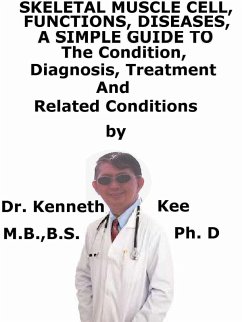A myocyte (muscle cell) is the type of cell present in muscle tissue.
They are long, tubular cells that originate developmentally from myoblasts to form muscles.
Muscle tissues originate from the mesodermal layer of embryonic germ cells.
There are specialized types of myocytes:
1.Skeletal muscle cells
2.Cardiac muscle cells
3.Smooth muscle cells
Cardiac myocytes are accountable for producing the electrical impulses that regulate the heart rate, among other functions.
A myoblast is a form of embryonic progenitor cell that separates to produce muscle cells.
Skeletal muscle fibers are produced when myoblasts join together.
Skeletal Muscle fibers thus have multiple nuclei (each nucleus coming from a single myoblast).
The combination of myoblasts is specific to skeletal muscle (e.g., biceps brachii) and not cardiac muscle or smooth muscle.
Skeletal Muscle cells have protein filaments that slide past one another producing a contraction that alters both the length and the shape of the cell.
Skeletal Muscles work to produce force and motion.
Life and Death of Skeletal Muscle Cell
My name is Muscle Man the skeletal muscle cell.
I was named Muscle Man by my friends who feel that I am very strong.
I was born in the body from a stem cell from the myotome during the development of the embryo.
During development, myoblasts (the muscle progenitor cells) either remain in the somite to form muscles linked with the vertebral column or migrate out into the body to form all other muscles.
Most of us migrate by following chemical signals to the proper locations where we fuse into elongate skeletal muscle cells.
Each of us is made up of cell which is surrounded by a cell membrane called the sarcolemma.
Beneath the membrane are found a large number of nuclei
I am called a structural syncythium which is a multinucleate cell which is the result from multiple cell fusions of uninuclear cells.
A muscle fiber forming part of a muscle may vary in length from 1 mm to 30cm in length.
Each of us is striated.
We consist of a number of parallel myofilaments showing light and dark bands.
The A band contains protein containing myosin while the T band contains the protein actin.
When I contract, my Actin filament actually slides across my T filament.
This movement can shorten my body to half of its length
The contraction of my body is brought about by the impulses from the motor neuron fiber which made contact with me at the myoneural junctions or motor end plates.
My nerve fiber supplies as many of 200 of us, meaning that it is a large motor unit.
When my muscle contracts to flex the forearm, the relaxation of the triceps muscles at the back of the upper arm produces a smooth contraction of the biceps (synergy of muscle).
When I contract, in addition to the proteins actin and myosin, I also need calcium, magnesium. ATP and ATPase
We muscles are mainly powered by the oxidation of fats and carbohydrates.
Anaerobic chemical reactions are also used mainly by fast twitch fibers.
Energy for my muscle contraction is supplied by the high energy ATP
We muscles conserve energy in the form of creatine phosphate which is produced from ATP and can regenerate ATP with creatine kinase.
We also keep a storage form of glucose in the form of glycogen.
Once the nerve cell is killed or dies from old age, my muscle cell is also affected and I will atrophy and die slowly.
We muscle cells are very healthy and live for a long time.
Fast death of a muscle cell is by necrosis through damage to my cell.
If no regeneration is possible then my cell will die rapidly.
TABLE OF CONTENT
Introduction
Chapter 1 Skeletal Muscle Cell
Chapter 2 Functions
Chapter 3 Life Cycle
Chapter 4 Disea...
Dieser Download kann aus rechtlichen Gründen nur mit Rechnungsadresse in A, B, CY, CZ, D, DK, EW, E, FIN, F, GR, H, IRL, I, LT, L, LR, M, NL, PL, P, R, S, SLO, SK ausgeliefert werden.


